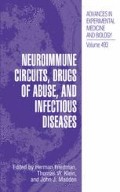Abstract
Opioids such as morphine are potent analgesic and addictive compounds. Chronic morphine use also induces immunomodulatory and immunosuppressive effects, as especially evident in HIV-infected patients. Morphine acts on the immune cells primarily through its binding to mu- opioid receptors on the plasma membrane. However, morphine modulation of immune functions still exists in mu-opioid receptor knockout mice, suggesting that in addition to the mu opioid receptors, morphine may also act by mechanisms mediated by either delta or kappa opioid receptors. To determine whether morphine activates kappa opioid receptors (KOR), a quantitative competitive RT-PCR procedure was utilized to quantify the KOR gene expression of morphine-treated cells. A segment of KOR transcript spanning the second extracellular loop, which has the reported dynorphin specificity, and the seventh transmembrane domain of the receptor was amplified from the total RNA of morphine-treated CEM x174 lymphocytes, along with a competitor molecule. The competitor was constructed by deleting a 33-nucleotide fragment from KOR. The results of the competitive RT/PCR indicated that CEMxl74 cells expressed KOR mRNA constitutively, in the order of femto-grams. Treatment of 10 μM of morphine resulted in the up-regulation of KOR gene expression 24 hr post-treatment. The observed morphine effect could be reversed by treating the cells with either naloxone (a KOR-partially selective antagonist) or nor-Binaltorphimine (a KOR-selective antagonist).
Access this chapter
Tax calculation will be finalised at checkout
Purchases are for personal use only
Preview
Unable to display preview. Download preview PDF.
References
Chuang, L.F., Chuang. T.K.. Killam, K.F.Jr., Qiu, Q., Wang, X.R., Lin, J-j, Kung, H-f, Sheng, W., Cliao, C., Yu, L., and Chuang, R.Y., Expression of kappa opioid receptors in human and monkey lymphocytes, Biochem. Biophys. Res. Commun. 209:1003–1010 (1995).
Chuang, L.F., Killam. K.F.Jr., and Chuang. R.Y., Opioid dependency and T-helper cell functions in rhesus monkey, In Vivo 7:159–166 (1993).
Chuang, L.F., Killam, K.F.Jr., and Chuang. R.Y.. SIV infection of macaques: a model for studying AIDS and drug abuse, Addiction Biol. 2:421–430(1997).
Gaveriaux-Ruff, C., Matthes, H.W.D.. Peluso. J., and Kieffer. B.L., Abolition of morphine-immunosuppression in mice lacking the μ-opioid receptor gene, Proc. Natl. Acad. Sci. USA 95:6326–6330 (1998).
Jordan, B.A., and Devi. L.A., G-protein-coupled receptor heterodimerizalion modulates receptor function, Nature 399:697–700(1999).
Law. P-Y, and Loh, H.H.. Regulation of opioid receptor activities. J. Pharmacol. Exp. Thera. 289:607–624 (1999).
Lawrence. D.M., el-Hamouly, W.. Archer, S., Leary, J.F., and Bidlack. J.M., Identification of kappa opioid receptors in the immune system by indirect immunofluorescence, Proc. Natl. Acad. Sci. USA 92:1062–1066 (1995).
Liu, Y., Blackbourn, D.J., Chuang, L.F., Killam, K.F.Jr., and Chuang, R.Y., Effects of in vivo and in vitro administration of morphine sulfate upon rhesus macaque polymorphonuclear cell phagocytosis and chemotaxis, J. Pharmacol. Exp. Thera. 263:533–539 (1992).
Miyagi, T., Chuang, L.F., Lam, K.M., Kung, H-f, Wang, J.M., Osburn, B.I., and Chuang, R.Y., Opioids suppress chemokine-mediated migration of monkey neutrophils and monocytes — an instant response, Immunopharmacology, in press (1999).
Reisine, T., and Pasternak, G. Opioid analgesics and antagonists. In: Hardman JG, Limbird LE, Molinoff PB, Ruddon RW and Gilman AG, Eds. The Pharmacological Basis of Therapeutics. McGraw-Hill Co., New York, 521–555 (1996).
Roy, S., Barke, R.A., and Loh, H.H., MU-opioid receptor-knockout mice: role of μ-opioid receptor in morphine mediated immune functions, Molecular Brain Res. 61:190–194 (1998).
Salter, R.D., Howell, D.N., and Cresswell, P., Genes regulating HLA class I antigen expression in T-B lymphoblast hybrids, Immunogenetics 21:235–246 (1985).
Author information
Authors and Affiliations
Editor information
Editors and Affiliations
Rights and permissions
Copyright information
© 2002 Kluwer Academic Publishers
About this chapter
Cite this chapter
Suzuki, S., Chuang, T.K., Chuang, L.F., Doi, R.H., Chuang, R.Y. (2002). Morphine Upregulates Kappa-opioid Receptors of Human Lymphocytes. In: Friedman, H., Klein, T.W., Madden, J.J. (eds) Neuroimmune Circuits, Drugs of Abuse, and Infectious Diseases. Advances in Experimental Medicine and Biology, vol 493. Springer, Boston, MA. https://doi.org/10.1007/0-306-47611-8_10
Download citation
DOI: https://doi.org/10.1007/0-306-47611-8_10
Publisher Name: Springer, Boston, MA
Print ISBN: 978-0-306-46466-9
Online ISBN: 978-0-306-47611-2
eBook Packages: Springer Book Archive

